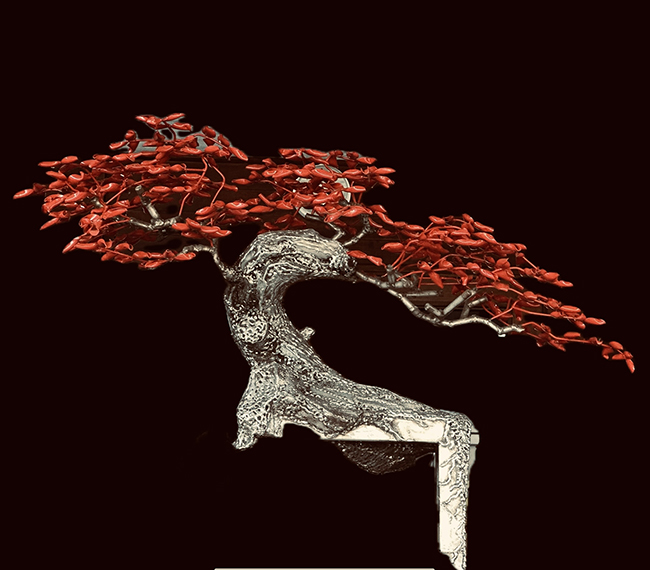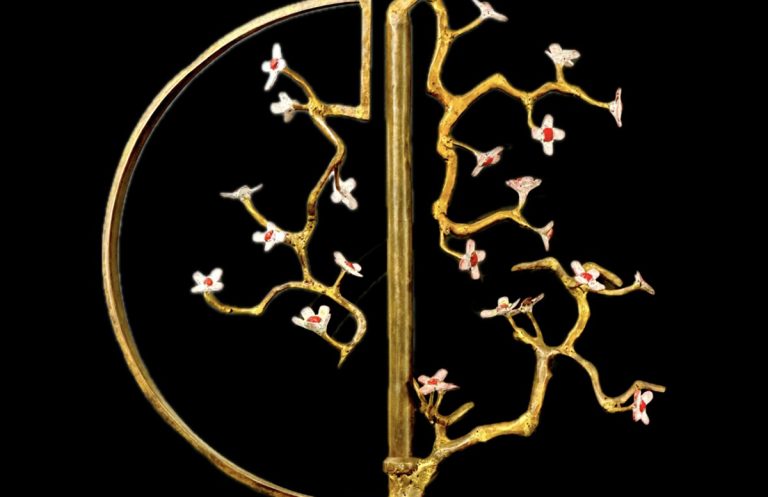DIGEMA, trained at the renowned National School of Fine Arts in Paris, fuses creativity, knowledge, and precision to craft art that highlights his unique perspective. His journey has been driven by experimentation and an unrelenting desire to create one-of-a-kind works. Central to his artistic philosophy is the idea of transformation and the interconnectedness of all things, which is beautifully expressed in his sculpture I Am Here. This piece, featuring a bronze hand releasing butterflies from a flower, draws inspiration from Spinoza’s concept of “Deus sive Natura” (God or Nature), emphasizing the inseparable link between humanity and the natural world. DIGEMA’s work blends nature, philosophy, and technical skill, constantly pushing the boundaries of traditional sculpture.

In Incandescence, DIGEMA uses stainless steel to represent a tree with flowing, organic curves that stand in contrast to the industrial material. The sculpture, shaped by heat, welding, and bending, appears to move despite the rigidity of the metal. The key to Incandescence lies in the contrast it presents. The tree, often associated with life and growth, is forged from a material typically connected to durability and strength. The bright red thermolacquered leaves add a burst of color to the otherwise cold and metallic structure. This balance of opposing elements symbolizes the tension between structure and vitality, exploring the relationship between nature and humanity. It highlights how we both influence and are influenced by the world around us.

Another of DIGEMA’s thought-provoking works is Duality, a bronze sculpture that delves into the interplay of opposites, particularly the masculine and feminine. The piece features inner and outer branches symbolizing these dual forces, with a broken circle suggesting incompleteness or disruption. From this break, flowers bloom, representing nature’s resilience and ability to flourish in adversity. The blossoms metaphorically unite strength and fragility, embodying DIGEMA’s skill in balancing contrasting ideas. Through Duality, viewers are invited to reflect on how opposing forces coexist and harmonize in life.

In Emerging Roots, inspired by Heidegger’s philosophy, DIGEMA explores existence and the constraints imposed by society. This bronze sculpture, created through a molding process, reflects the limitations humans face. Drawing from Heidegger’s concept of “thrownness,” which suggests that humans are cast into existence with certain limitations, the sculpture portrays rooted feet as symbols of confinement, much like plants bound by their environment. However, the upward movement in the piece signifies the human desire to break free from these constraints. This interplay between confinement and freedom is central to Emerging Roots, illustrating the human pursuit of transcendence and self-determination. The emerging elements in the sculpture symbolize hope, resilience, and the potential to rise above limitations.
DIGEMA’s body of work embodies his philosophical insights. His sculptures tackle complex themes like existence, duality, and nature. Rather than merely being objects of visual appeal, his pieces prompt deeper thought and invite viewers to reflect on their place within the natural and philosophical world. DIGEMA uses sculpture not only as a form of artistic expression but as a way to raise questions and inspire contemplation.
His sculpture I Am Here, with its bronze hand and butterflies, exemplifies his ability to bridge the physical and metaphysical. The relationship between humanity and nature is a recurring theme in DIGEMA’s work, from the flowing curves of Incandescence to the symbolic opposites in Duality and the existential exploration of Emerging Roots. His art is centered on transformation—both of materials and ideas. This ever-changing nature gives his work a sense of vitality, even when made from materials like steel and bronze.
For DIGEMA, art is a dynamic reflection of existence, always in motion. His sculptures are far from static; they embody the constant process of change that characterizes the world. Through his creations, DIGEMA encourages us to consider our own transformations and connections to both the natural world and broader philosophical concepts.

